Diffuse emission of Galactic high-energy neutrinos
arXiv:2211.15607 [astro-ph.HE]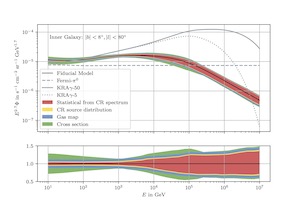
In the standard picture, the Galaxy is pervaded by a population of non-thermal, high-energy particles: cosmic rays. In inelastic nuclear interactions, those produce high-energy gamma-rays and neutrinos. Whereas gamma-rays can also originate from interactions of high-energy electrons, neutrinos are uniquely produced in interactions of hadronic cosmic rays. A detection of this so-called diffuse emission in high-energy neutrinos therefore constitutes a crucial test for our understanding of cosmic rays. We have proposed this state-of-the-art model for TeV-PeV diffuse emission, based on a fit to local measurements of cosmic rays. We have also quantified the uncertainties from the fit and from various modelling choices, e.g. the adopted gas distribution. Our results will be important for future observations by neutrino observatories like IceCube.
Stochastic Fluctuations of Low-Energy Cosmic Rays
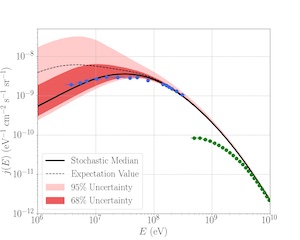
In models of cosmic ray transport, it is usually assumed that the density of sources in the Galaxy can be approximated by a smooth function of position and time. However, sources are spatially and temporally well-defined structures. This can make a difference, if the propagation times and distances are limited, for instance by energy losses, as for cosmic ray protons and electrons of MeV energies. Given our ignorance of source distances and ages, one can only make statistical predictions in this case. We have investigated the stochastic nature of the proton and electron intensities and computed the median intensity and the uncertainty bands. We can show that the median spectrum shows a spectral feature that is seen in the data, but that previously had required ad hoc modfications. Our model instead reproduces both Voyager and AMS-02 data without the need for an unnatural break in the source spectrum.
arXiv:2209.10581 [astro-ph.HE]
Recently, we have also predicted the contribution of cosmic rays to the ionisation of molecular clouds. A better understanding of the cosmic ray induced ionisation is crucial for our understanding of star formation. However, the cosmic ray ionisation rate is usually underpredicted in cosmic ray models by one to two orders of magnitude with a large scatter. In the stochastic framework explained above, this scatter is easily explained: Clouds at different positions will experience cosmic ray intensities that can differ by orders of magnitude. In addition, we have studied the dependence of the predictions on the preferred position of molecular clouds. If clouds are in interarm regions, then the models still fall short of explaining the data. If instead, clouds are more likely to exist in spiral arms, then we can explain the ionisation data rather well.
Bayesian inference of 3D gas maps
Astron. Astrophys. 655 (2021) A64,
and
arXiv:2012.15770 [astro-ph.GA]and
arXiv:2202.02341 [astro-ph.GA] (accepted for publication in Astron. Astrophys.)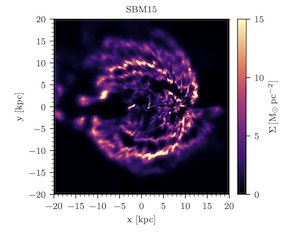
The 3D spatial distribution of gas in the Galaxy is an important input for much of galactic astrophysics. For instance, for diffuse emission gas constitutes the target density and thus largely determines the spatial morphology of the resulting sky maps. From our vantage point, the 3D distribution can be reconstructed from gas line surveys. However, with the existing techniques, those reconstructions were limited by a number of artefacts, e.g. the well-known finger-of-god effects. We have used methods from information field theory (IFT) to exploit the correlation structure in the gas densities, allowing us to cure a number of such artefacts. Our new, 3D reconstructions of atomic and molcular hydrogen gas are of the highest resolution. The 3D densities and 2D surface mass densities and are available here and here.
Acceleration of secondaries in old supernova remnants
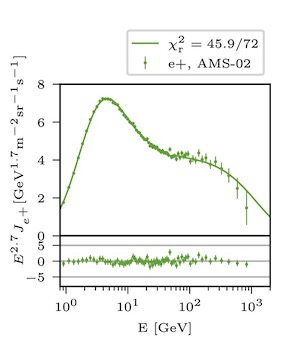
Measurements of cosmic ray nuclei allow to infer the amount of matter that cosmic rays typically experience between acceleration and observation, the so-called grammage. It is usually assumed that the grammage is exclusively accumulated during propagation through the Galaxy. However, if cosmic rays undergo inelastic nuclear interaction near the shock front of a supernova remnant, the abundances of cosmic ray nuclei, positrons and antiprotons can get altered. Specifically, the additional particles can attain a harder spectrum. This possibility was suggested as a possible explanation of the excess of hard positrons, observed by the PAMELA, Fermi-LAT and AMS-02 experiments. This is an attractive scenario, since no additional source of positrons would be required, but previously no systematic scan of the parameter space had been performed. Such a study is made difficult by the large number of parameters necessary to explain the modern, high-precision data sets from AMS-02. We have managed to systematically study the parameter space and have identified a set of best-fit parameters that can coherently explain AMS-02 data on positrons, antiprotons and a large set of nuclei.
An extended force-field model of solar modulation
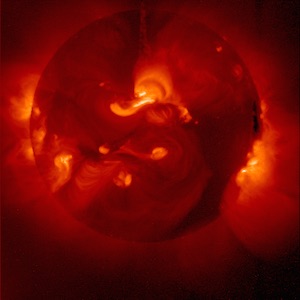
The locally observed fluxes of cosmic rays at GeV energies are significantly suppressed by the magnetised solar wind, a process that is referred to as solar modulation. In the past, this effect has been modelled with the over-simplified force field approach or with computationally expensive numerical codes. We have recently presented a very powerful, yet simple extension to the force-field model that is ideally suited for phenomenological studies as for instance in dark matter indirect searches. While it is much faster than the complex numerical models, it still allows taking into account not only advection and diffusion, but also the charge-sign dependent drifts. We have tested it against our own numerical code and found it to give an excellent description in the energy range of interest for AMS-02, that is above a few hundred MeV. We have found our model parameters to correlate with solar wind parameters and using this correlation, we have been able to predict the time-dependence of modulated fluxes beyond the range for which AMS-02 has presented data.
Cosmic ray small-scale anisotropies
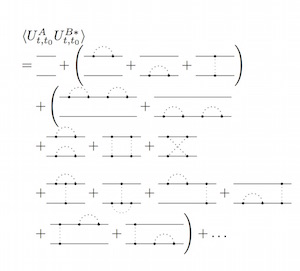
The distribution of arrival directions of TeV-PeV cosmic rays show variations on angular scales as small as 5° whereas conventional diffusion models only predict large scale anisotropies, that is variation on scales 90°. It had been suggested earlier that this is a consequence of the local realisation of turbulence and we had studied this effect in numerical simulations and in some effective models. Recently, however, we have presented a first principles approach that allows computing the angular power spectrum of cosmic ray anisotropies for a given spectrum of magnetic turbulence. This relies on a computation of the two-point function of the cosmic ray angular distribution which we performed in a perturbative approach similar to Feynman diagrams in quantum field theory. We have shown that even a simple toy model of turbulence already reproduces the correlated transport of pairs of cosmic rays which is at the root of the formation of small-scale anisotropies.
More recently, we have computed the angular power spectrum of the small-scale anisotropies in a more realistic model of turbulence. To test our analytical model, we have run a large suite of test-particle simulations, making extensively use of graphical processing units. Our analytical predictions agree very well with the simulation results. In the future, comparison with observational data will allow another handle on the nature of interstellar turbulence.
Neutrino clustering in the Milky Way and beyond
arXiv:1910.13388 [astro-ph.CO]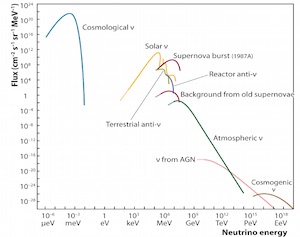
Detection of relic backgrounds of neutrinos produced in the Big Bang would be the last missing piece of evidence for the standard cosmological model. Experimental efforts are underway, but they rely on precise predictions for the local density of this cosmic neutrino background. This density can be enhanced compared to the cosmological average due to gravitational clustering of the non-relativistic neutrinos in the gravitational potentials of the Milky Way and nearby objects like the Andromeda galaxy or the Virgo cluster. Traditionally, this is computed by forward-tracking particles through the gravitational potential starting at high redshifts. This is computationally very expensive such that only a simplified system with rotational symmetry could be considered while there is no such symmetry in reality. Recently, we have studied gravitational clustering making use of the back-tracking technique that allows to compute the enhancement much more efficiently. Given the speed of our simulations, we have been able to take into account the three-dimensional gravitational potential of the Galaxy and those of Andromeda and Virgo. While the effect of Andromeda is small, we have found that Virgo can significantly enhance the clustering of neutrinos.
Phenomenology of cosmic ray electrons and positrons
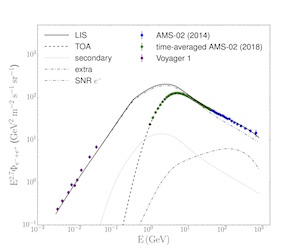
Cosmic ray electrons and positrons are an exciting probe for indirect searches of dark matter, but also for studying the origin of cosmic rays. We have recently contributed to the phenomenology of cosmic ray electrons and positrons, making use of the latest data from experiments like AMS-02, H.E.S.S. and Voyager 1, but also modellung diffuse emission at radio frequencies. We have also made use of the time-dependent electron-positron fluxes recently presented by AMS-02. Together with our local colleagues from the AMS collaboration, we have analysed data over a wide energy range from tens of MeV to 1 TeV and proven that modelling these data requires a number of spectral breaks, both in the source spectra, but also in the interstellar diffusion coefficient.
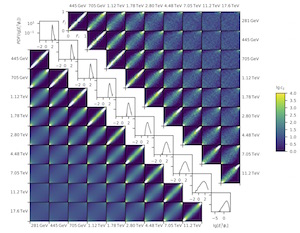
We have also presented an explanation for the spectral break at 1 TeV observed by H.E.S.S. and recently confirmed by DAMPE. We have shown that this feature can naturally be produced from a random realisation of stochastic electron and positron sources like supernova remnants. In a careful statistical analysis, we have computed the variance of the flux expected from a random ensemble and for the first time also considered the correlation between different energy bins. We have been able to prove that a stochastic model is statistically compatible with the H.E.S.S. data, but requires a supernova rate about one order of magnitude smaller the canonical of three per century. This could be taken as evidence that supernova remnants do not occur independently, but are taking place in clusters of tens or hundreds.
The Fermi bubbles from a Galactic wind
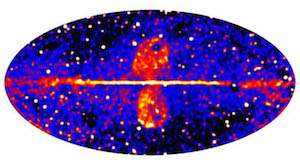
The Fermi bubbles are a pair of bi-lobular structures seen in GeV gamma-rays by the Fermi-LAT satellite experiment. Given their position and symmetry in the sky, they are likely formed by an episode of energy injection at the Galactic centre. The leading contenders for the source of energy are accretion onto the supermassive black hole Sgr A* and an episode of increased star formation activity. We have investigated the latter scenario with a very detailed numerical study of non-thermal acceleration, transport and energy loss processes for high-energy electrons. We have shown that the spectrum and morphology of the bubbles can only be produced if the diffusion is markedly anisotropic and enhanced in a shell around the edge of the Fermi bubbles. If it could be shown that such a good fit is not possible in the accretion models, then our model would single out nuclear star formation as the origin of the Fermi bubbles.